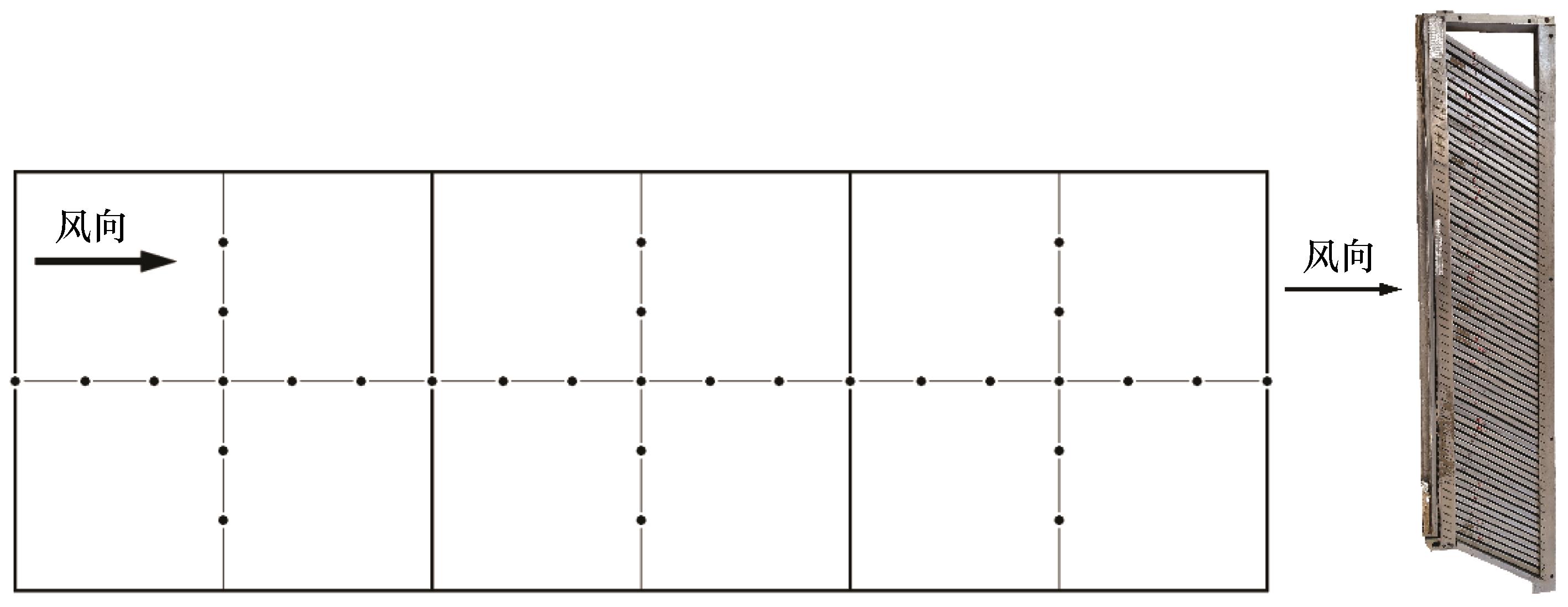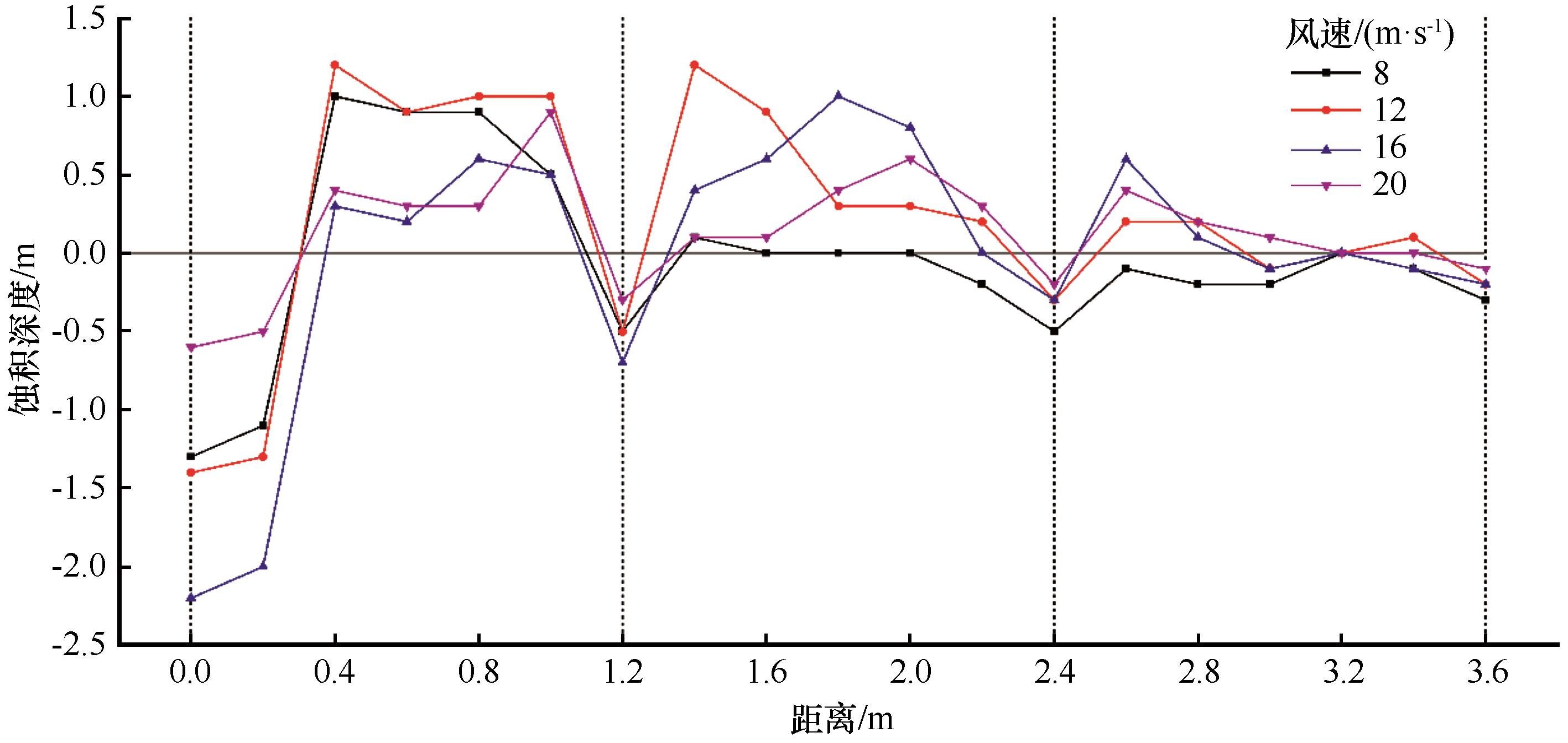
- CN 62-1070/P
- ISSN 1000-694X
- Bimonthly 1981

Journal of Desert Research ›› 2024, Vol. 44 ›› Issue (3): 290-297.DOI: 10.7522/j.issn.1000-694X.2023.00113
Zhengyi Yao1( ), Jianjun Qu1,2(
), Jianjun Qu1,2( ), Jianhua Xiao1, Ruyan Wang3, Shengli Han3, Wenfu Lu4
), Jianhua Xiao1, Ruyan Wang3, Shengli Han3, Wenfu Lu4
Received:2023-09-25
Revised:2023-12-11
Online:2024-05-20
Published:2024-06-11
Contact:
Jianjun Qu
CLC Number:
Zhengyi Yao, Jianjun Qu, Jianhua Xiao, Ruyan Wang, Shengli Han, Wenfu Lu. Wind tunnel simulation on the sand fixation performance of a kind of brush shaped Salix psammophila sand barrier[J]. Journal of Desert Research, 2024, 44(3): 290-297.
Add to citation manager EndNote|Ris|BibTeX
URL: http://www.desert.ac.cn/EN/10.7522/j.issn.1000-694X.2023.00113

Fig.2 Layout of measurement points for erosion and accumulation characteristics on surface of mobile sand in the wind tunnel and sand trap for collecting sands

Fig.4 Erosion and accumulation characteristics on surface of mobile sand under different wind speeds in the wind tunnel (dashed lines indicate the location of sand barriers)
| 参数 | 风速/(m·s-1) | ||
|---|---|---|---|
| 12 | 16 | 20 | |
| q0 | -0.05134 | -0.49579 | -1.38037 |
| z0 | 1.14592 | 1.11136 | 1.03418 |
| a1 | 0.04914 | 0.57152 | 1.8804 |
| b1 | 1.60492 | 1.32901 | 1.08722 |
| a2 | 0.09282 | 0.40067 | 1.05406 |
| b2 | 1.63818 | 1.37296 | 1.11176 |
| a3 | 0.09032 | 0.89532 | 2.40472 |
| b3 | 74.88796 | 95.61356 | 113.33693 |
| R2 | 0.98778 | 0.9806 | 0.97412 |
| P | <0.01 | <0.01 | <0.01 |
Table 1 Parameters of the wind sand flow structure with sand barriers in the wind tunnel
| 参数 | 风速/(m·s-1) | ||
|---|---|---|---|
| 12 | 16 | 20 | |
| q0 | -0.05134 | -0.49579 | -1.38037 |
| z0 | 1.14592 | 1.11136 | 1.03418 |
| a1 | 0.04914 | 0.57152 | 1.8804 |
| b1 | 1.60492 | 1.32901 | 1.08722 |
| a2 | 0.09282 | 0.40067 | 1.05406 |
| b2 | 1.63818 | 1.37296 | 1.11176 |
| a3 | 0.09032 | 0.89532 | 2.40472 |
| b3 | 74.88796 | 95.61356 | 113.33693 |
| R2 | 0.98778 | 0.9806 | 0.97412 |
| P | <0.01 | <0.01 | <0.01 |
| 1 | 吴正.风沙地貌与治沙工程学[M].北京:科学出版社,2003:319-330. |
| 2 | 王涛.中国风沙防治工程[M].北京:科学出版社,2011:171-201. |
| 3 | 兰州沙漠研究所沙坡头沙漠科学研究站.包兰铁路沙坡头段固沙原理与措施[M].银川:宁夏人民出版社,1991:52-94. |
| 4 | Qiu G Y, Lee I B, Shimizu H,et al.Principles of sand dune fixation with straw checkerboard technology and its effects on the environment[J].Journal of Arid Environments,2004,56:449-464. |
| 5 | Zhang C L, Zou X Y, Pan X H,et al.Near-surface airflow field and aerodynamic characteristics of the railway-protection system in the Shapotou region and their significance[J].Journal of Arid Environments,2007,71:169-187. |
| 6 | Dong Z B, Chen G T, He X D,et al.Controlling blown sand along the highway crossing the Taklimakan Desert[J].Journal of Arid Environments,2004,57:329-344. |
| 7 | Li C J, Wang Y D, Lei J Q,et al.Damage by wind-blown sand and its control measures along the Taklimakan Desert Highway in China[J].Journal of Arid Land,2021,13:98-106. |
| 8 | 雷加强,李生宇,靳正忠,等.塔里木沙漠公路防护林生态工程的综合生态环境效应[J].科学通报,2008():169-178. |
| 9 | Wang T, Qu J J, Niu Q H,et al.Aerodynamic properties and shelter effects of a concrete plate-insert sand fence along the Lanzhou-Xinjiang High-Speed Railway in gobi regions under strong winds[J]. Frontiers in Environmental Science,2022,10:861063. |
| 10 | Qu J J, Wang T, Niu Q H,et al.Mechanisms of the formation of wind-blown sand hazards and the sand control measures in gobi areas under extremely strong winds along the Lanzhou-Xinjiang high-speed railway[J]. Science China Earth Science,2023,66:292-302. |
| 11 | Cheng J J, Xue C X.The sand-damage-prevention engineering system for the railway in the desert region of the Qinghai-Tibet Plateau[J].Journal of Wind Engineering and Industrial Aerodynamics,2014,125:30-37. |
| 12 | 韩致文,郭彩贇,钟帅,等.库布齐沙漠HDPE网和植物纤维网沙障防沙试验效应[J].中国沙漠,2018,38(4):681-689. |
| 13 | 李敏岚,屈建军,唐希明,等.高密度聚乙烯(HDPE)蜂巢式沙障对土壤水分的影响[J].中国沙漠,2020,40(1):136-144. |
| 14 | 党晓宏,高永,虞毅,等.新型生物可降解PLA沙障与传统草方格沙障防风效益[J].北京林业大学学报,2015,37(3):118-125. |
| 15 | 屈建军,洪贤良,李芳,等.聚乳酸(PLA)网格沙障耐老化性能及防沙效果[J].中国沙漠,2021,41(2):51-58. |
| 16 | 刘晋浩,周安民,倪平利.多功能立体固沙车:CN201774804U[P].2011-03-30. |
| 17 | 张林,孙步功,张克平,等.我国治沙机器的研究现状与展望[J].林业机械与木工设备,2022,50(12):4-8. |
| 18 | 屈建军,张国祥,牛清河,等.一种刷状网绳式草方格沙障:CN210766711U[P].2020-06-16. |
| 19 | 张守功.科学技术赋能防沙治沙[N].人民日报,2023-07-21(19). |
| 20 | 屈建军,柳本立,孟晨,等.刷状沙柳沙障生产装置:CN219470885U[P].2023-08-04. |
| 21 | 高永,虞毅,龚萍,等.沙柳沙障[M].北京:科学出版社,2013:1-9. |
| 22 | 高永.沙柳沙障防沙治沙技术研究综述[J].内蒙古农业大学学报(自然科学版),2022,43(5):56-60. |
| 23 | 蒙仲举,任晓萌,高永.半隐蔽式沙柳沙障的防风阻沙效益[J].水土保持通报,2014,34(3):178-180. |
| 24 | 赵国平,左合君,徐连秀,等.沙柳沙障防风阻沙效益的研究[J].水土保持学报,2008(2):38-41. |
| 25 | 王翔宇,丁国栋,高函,等.带状沙柳沙障的防风固沙效益研究[J].水土保持学报,2008(2):42-46. |
| 26 | 赵国平,胡春元,张勇,等.高立式沙柳沙障防风阻沙效益的研究[J].内蒙古农业大学学报(自然科学版),2006(1):59-63. |
| 27 | 高永,邱国玉,丁国栋,等.沙柳沙障的防风固沙效益研究[J].中国沙漠,2004,24(3):111-116. |
| 28 | 张亚玲,王翔宇,高函,等.沙柳沙障防风效益模拟试验研究[J].水土保持应用技术,2007(6):3-5. |
| [1] | Yue Li, Haibing Wang, Chengxian Liao, Xue Zhang, Tianhong Hua, Minjie Yan. Wind tunnel simulation of gobi sand movement and its effect on gravel cover age of underlying surface [J]. Journal of Desert Research, 2024, 44(3): 194-201. |
| [2] | Li Cheng, Zhiying Ning, Hongling Yang, Yulin Li. Effects of different sand-fixation measures on vegetation and soil characteristics of high and flat mobile dunes [J]. Journal of Desert Research, 2024, 44(2): 273-282. |
| [3] | Guanglu Hu, Haizhi Chen, Jin Ma, Hu Tao, Chengqian Zhou, Peng Liu. Windbreak and sand-fixation effects of typical shrub plants in the desert-oasis transitional zone in the middle reaches of the Heihe River [J]. Journal of Desert Research, 2023, 43(5): 31-40. |
| [4] | Jinfeng Wang, Xiaoling Liu, Qing Li, Rende Wang, Sheng Wang. Spatio-temporal differentiation and driving factors of windbreak and sand fixation services in wind erosion area of the northern Loess Plateau [J]. Journal of Desert Research, 2023, 43(4): 220-230. |
| [5] | Xiaoqin Yuan, Shengquan Liu, Feng Ai, Zheng Zhang, Qiang Li, Jinyu Jiang, Changchun Shi. Wind erosion resistance of litter of Salix psammophila community in the southeast edge of Mu Us Sandy Land, China [J]. Journal of Desert Research, 2022, 42(1): 134-138. |
| [6] | Lin Shi, Yuxing Zhao, Eerdun Hasi, Ping Zhang, Yingjun Xu, Zhuoran Wang. Changes of vegetation and soil nutrient on windward slope of dune under sand barrier environment in Mu Us Sandy Land [J]. Journal of Desert Research, 2021, 41(5): 140-146. |
| [7] | Haifeng Yang, Anyu Li, Jiaqi Wang, Guosheng Zhang, Shusen Wang, Xin Zhang. Identification of fasciation phenotype and anatomic structure analysis in Salix psammophila [J]. Journal of Desert Research, 2021, 41(4): 45-50. |
| [8] | Jianjun Qu, Xianliang Hong, Fang Li, Xiao Feng, Yijiang Meng, Yiyang Ding, Mingquan Yang. Aging resistance of polylacticacid sand barriers and its sand fixation effectiveness [J]. Journal of Desert Research, 2021, 41(2): 51-58. |
| [9] | Xiaoxu Wang, Ping Yan, Yong Wang, Miao Dong, Yijiao Wang, Xiao Zhang. Effects of slope gradient and shape on climbing dunes: a wind tunnel experiment [J]. Journal of Desert Research, 2020, 40(6): 118-126. |
| [10] | Bao Yanfeng, Wang Xuequan, Yao Bin, Hao Yuguang, Liu Fang, Xin Zhiming, Li Yonghua. Windbreak effect of superimposed narrow belt and small net shelterbelts base on wind velocity flow field [J]. Journal of Desert Research, 2020, 40(2): 185-194. |
| [11] | Yu Yanping, Xiao Jianhua, Qu Jianjun, Li Fang, Li Wanqiang, Pan Duoming, Wu Qingrui, Hong Xuefeng, Tian Yongzhen. Wind Tunnel Simulation of Aeolian Sand Process in Subgrade Section of Two Typical High-Grade Highway [J]. Journal of Desert Research, 2019, 39(1): 68-79. |
| [12] | Yu Yanping, Xiao Jianhua, Qu Jianjun, Wei Mingnian, Pan Duoming, Hong Xuefeng, Tian Yongzhen, Li Fang. Wind Tunnel Test on Flow Field of Highway Subgrade with Different Slope Angles [J]. Journal of Desert Research, 2018, 38(3): 464-472. |
| [13] | Du Jun, Li Yixuan, Yang Xiaoxia, Li Yunfei, Ma Xiaojun. Effects of Biological Soil Crusts Types on Soil Physicochemical Properties in the Southeast Fringe of the Tengger Desert [J]. JOURNAL OF DESERT RESEARCH, 2018, 38(1): 111-116. |
| [14] | Yuan Xinxin, Wang Haifeng, Lei Jiaqiang, Li Shengyu, Kang Xiangguang, Ma Xuexi. Wind Tunnel Simulation of Windbreak Effect of Double-row Nylon Net Fence with Different Interval [J]. JOURNAL OF DESERT RESEARCH, 2016, 36(5): 1238-1246. |
| [15] | Li Shengyu, Sun Na, Ma Xuexi, Xu Xinwen. The Characteristics and Significances of the Sand Cemented Bodies Discovered on Inter-dune Corridor in Central Taklimakan Desert [J]. JOURNAL OF DESERT RESEARCH, 2016, 36(2): 265-273. |
| Viewed | ||||||
|
Full text |
|
|||||
|
Abstract |
|
|||||
©2018Journal of Desert Research
Tel:0931-8267545
Email:caiedit@lzb.ac.cn;desert@lzb.ac.cn
Support:Magtech